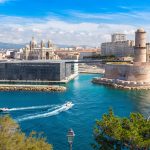
The Loire River, France’s longest, begins in the highlands of the Massif Central. Flowing north and then west to the Bay of Biscay, the Loire has been the backbone of French power for centuries. The Loire and Seine form the borders of the Beauce, an exceptionally fertile tract of land in central France that is one of the most productive agricultural regions in the world. Its surpluses have guaranteed food security for the French for centuries. The drainage plain of the Loire Valley is famous for its vineyards and wine, but orchards and other crops also thrive in the fertile soil.
The Loire’s navigability coupled with the ability to grow surplus crops made the region an early and potent generator of wealth. The Loire Valley was home to Gaulish and Roman seats of power before giving rise to the Franks and the modern French. Its location within the center of France has left the Loire Valley relatively insulated and secure. It’s called the Valley of the Kings for good reason.
The valley has more than 1,000 chateaux, which began as fortified castles in the Middle Ages. They gave rise to the beautiful Renaissance castles and country homes that became fashionable as France became a more dominant and secure European power.
The Loire River empties into the Atlantic at Saint-Nazaire, France’s window on the world. The Seine makes France a northern European power, the Rhone a southern European power, but it is the Loire that makes France a global power. Saint-Nazaire has been one of France’s premier naval bases as long as there has been a France.



